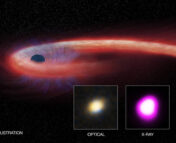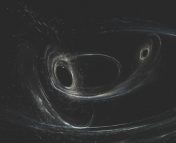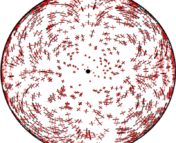Title: High-redshift supermassive black hole mergers in simulations with dynamical friction modelling
Authors: Colin DeGraf, Nianyi Chen, Yueying Ni, Tiziana Di Matteo, Simeon Bird, Michael Tremmel, Rupert Croft
First Author’s Institution: Department of Physics, Truman State University, Kirksville
Status: Submitted to MNRAS, available on arXiv
Ground-based gravitational wave (GW) detectors like LIGO and Virgo have been detecting gravitational waves from stellar-mass black hole mergers for the past several years. Higher-mass mergers like between two supermassive black holes (SMBH) produce gravitational waves with longer wavelengths. These mergers are beyond the sensitivity of the current gravitational wave detectors but will be seen by the future space-based gravitational-wave detector Laser Interferometer Space Antenna (LISA).
Supermassive black holes are found at the center of galaxies and have a “special relationship” with their host galaxies. When two galaxies merge, the central BHs move toward the new galactic center, forming an SMBH binary and eventually merging. Since the gravitational waves from such SMBH mergers are expected to be seen in LISA, it is necessary to study their population and get a prediction of their merger rates and the GW signals. As cosmological simulations model BHs and galaxy evolution and span a wide range of redshift (effectively cosmic time), they are the perfect tool for probing the population of SMBH mergers. In today’s paper, the authors study the Astrid simulation to characterize supermassive black hole mergers at high redshift (z > 2).
Merging populations in the simulation
The authors use the Astrid cosmological simulation to model the merging black hole population. Most cosmological simulations only resolve higher-mass black holes (around solar masses) and it misses a lot of LISA-detectable mergers. The Astrid simulation however can resolve lower-mass black hole mergers as it uses a lower-mass seed model ( down to
solar masses). Astrid also implements dynamical friction that accounts for the effective loss of kinetic energy and momentum of the black holes through gravitational interaction with surrounding matter. This helps in accurately modeling the orbital dynamics of the inspiralling BHs to small scales.
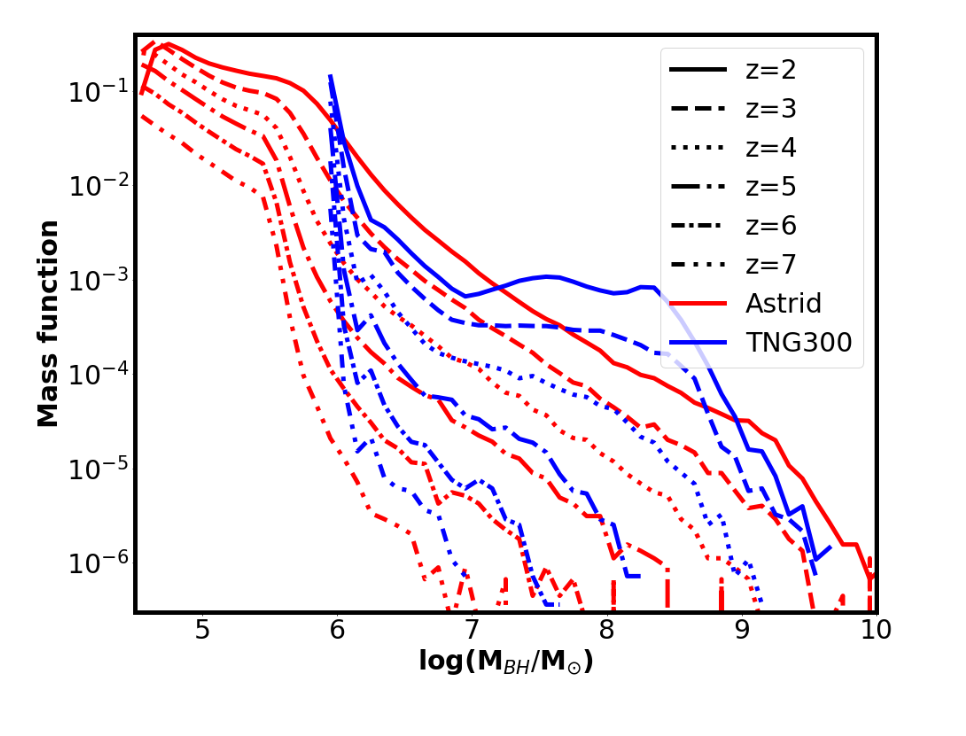
To study how accounting for dynamical friction and a lower-mass seed affects the merging black hole population, the authors compare results from the Astrid simulation to another cosmological simulation: TNG300. Figure 1 shows the overall black hole populations in both cosmological simulations over cosmic time. We can see that the Astrid model (in red) spans a wide range of black hole masses across all redshift values whereas the TNG300 simulation has a large spike at around solar mass which corresponds to the lowest seed mass used in the TNG simulation. Both the models broadly agree above the TNG seed mass (
) for higher redshifts but TNG produces more higher mass black holes at lower redshifts (later times).
Expectations for LISA
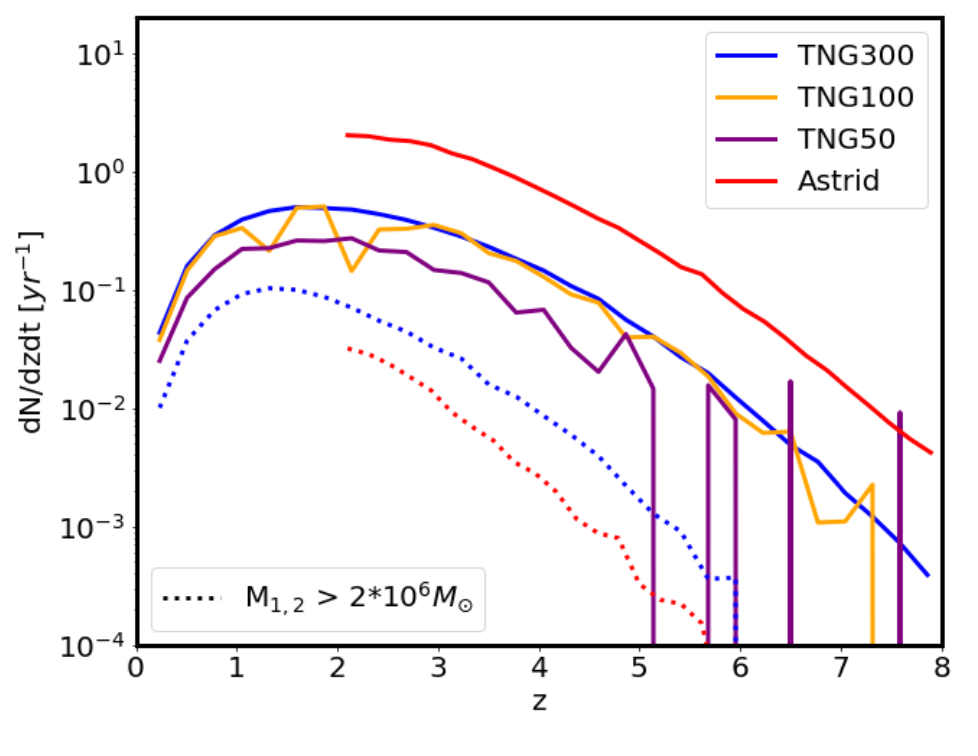
The authors calculate the rate at which gravitational wave signals from SMBH reach LISA by integrating the total mergers in the simulation over all redshift values. Figure 2 shows the merger rate as a function of redshift for the Astrid and TNG simulations. Astrid simulation has a higher merger rate than all the other TNG simulations as it includes black holes much lower in mass than those in TNG. However, when limiting Astrid to black hole mergers massive enough to be resolved in TNG300 (red dotted lines), we see that Astrid has a lower merger rate than TNG300. This is because, in the Astrid simulation, the black holes take longer to inspiral towards the galactic center due to the inclusion of dynamical friction. Therefore the inclusion of low-mass seeds and a dynamical friction model significantly affects the BH merger rates in cosmological simulations.
The authors also compute the expected gravitational wave signals from the BH mergers in the simulation and plot the GW strain (the strain is effectively a measure of the GW magnitude) against their frequencies (see Figure 3). When we compare the strain-frequency plot of Astrid (Figure 3a) to that of TNG (Figure 3b), it is clear that the TNG simulations only cover the low-frequency high-strain regime. Therefore, including lower-mass seed black holes, which produce higher GW signal frequencies, is crucial to probe the full range of LISA detections. The authors verify this with Figure 3c where they limit the mergers in Astrid to the same mass range as TNG and we see the higher frequency portion of the plot missing.
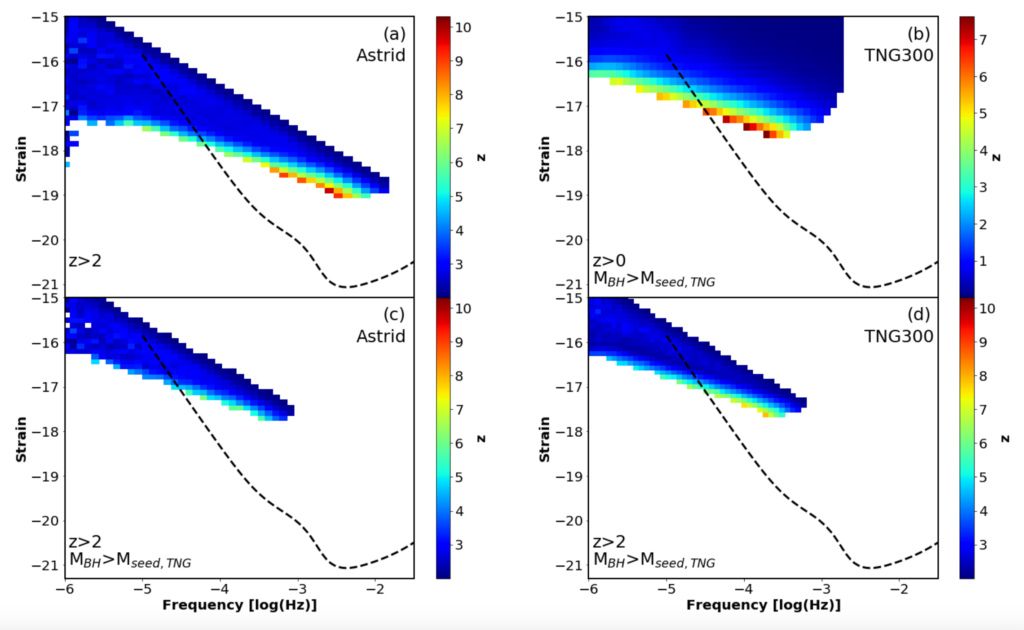
In conclusion, the authors use the cosmological simulation Astrid to illustrate the importance of using a wide range of black hole seed mass down to lower mass black holes to help in probing BH mergers visible over a wide range of LISA detections. Further, they demonstrate the need to account for dynamical friction in cosmological simulations as it accurately models the smaller scale dynamics of the inspiralling BHs. Thus, cosmological simulations like the Astrid and TNG can help us in predicting expected gravitational wave signals in future gravitational wave observations.
Astrobite edited by Megan Masterson
Featured image credit: Adapted from illustris, NASA and Wikimedia Commons

